😶🌫AP BIO Chapter 41 - Species Interactions
Overview
41.1 Interactions within a community may help, harm, or have no effect on the species involved
41.2 Diversity and trophic structure characterize biological communities
41.3 Disturbance influences species diversity and composition
41.4 Biogeographic factors affect community diversity
41.5 Pathogens alter community structure locally and globally
BIG IDEAS: Interactions between populations affect the distribution and reproductive success of populations (Big Ideas 1 & 4) by limiting or providing free energy and matter (Big Idea 2)
[[Community:[[
All the organisms that inhabit a particular area; an assemblage of populations of different species living close enough together for potential interaction
41.1 - Interactions within a community may help, harm, or have no effect on the species involved
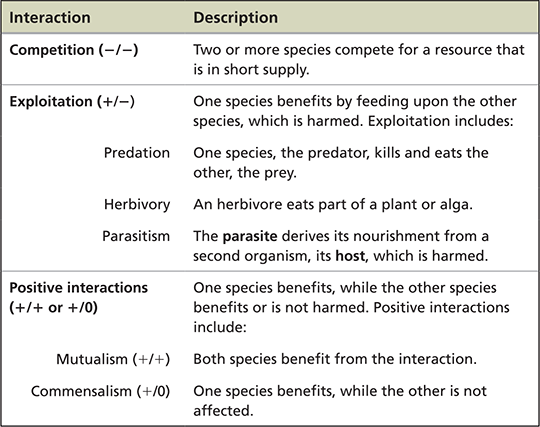
Competitive exclusion states that two species competing for the same resource cannot coexist permanently in the same place
Resource partitioning is the differentiation of ecological niches that enables species to coexist in a community
[[Interspecific Interactions:[[
A relationship between individuals of two or more species in a community
Identify which categories of interactions are -/-, +/-, and +/+ (or +/0) respectively
Competition, exploitation (predation, herbivory, and parasitism), and positive interactions (mutualism and commensalism)
[[Interspecific Competition:[[
Competition for resources between individuals of two or more species when resources are in short supply
Two species are grown separately and have increase population at levels off at carrying capacity. When the species are grown together, one becomes extinct. This shows that ___
- Two species competing for the same limiting resources cannot coexist permanently in the same place
[[Competitive Exclusion:[[
The concept that when populations of two similar species compete for the same limited resources, one population will use the resources more efficiently and have a reproductive advantage that will eventually lead to the elimination of the other population
[[Ecological Niche:[[
The sum of a species’ use of the biotic and abiotic resources in its environment
[[Resource Partitioning:[[
The division of environmental resources by coexisting species such that the niche of each species differs by one or more significant factors from the niches of all coexisting species
Resource partitioning among Dominican Republic lizards - Seven species of Anolis lizards live in close proximity, and all feed on insects and other small arthropods. However, competition for food is reduced because each lizard species has a different preferred perch, thus occupying a distinct niche
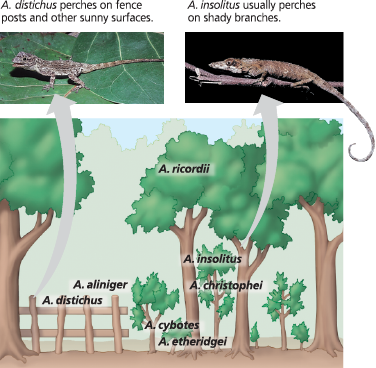
[[Fundamental Niche:[[
The niche potentially occupied by that species
[[Realized Niche:[[
The portion of its fundamental niche a species actually occupies
Two rocks occupy a coast. If one species is removed, how might this affect the realized niche of the other? 
Chthamalus spread into the region formerly occupied by Balanus. Interspecific competition makes the realized niche of Chthamalus much smaller than its fundamental niche 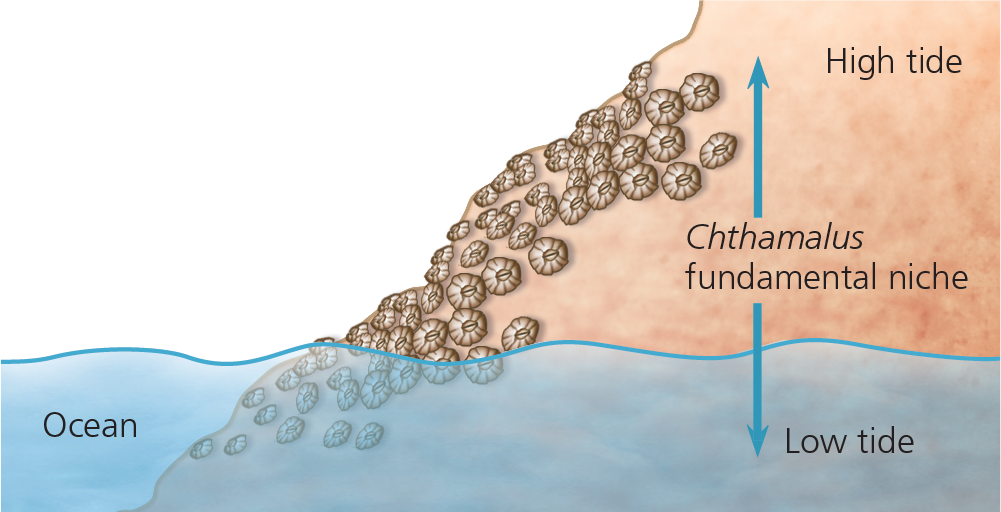
Other observations showed that Balanus cannot survive high on the rocks because it dries out during low tides. How would Balanus’s realized niche compare with its fundamental niche?
Its realized and fundamental niches would be similar, unlike those of Chthamalus
[[Character Displacement:[[
The tendency for characteristics to be more divergent in sympatric populations of two species than in allopatric populations of the same two species
Character displacement: indirect evidence of past competition - Allopatric populations of Geospiza fuliginosa and Geospiza fortis on Los Hermanos and Daphne Islands have similar beak morphologies (top two graphs) and presumably eat similarly sized seeds. However, where the two species are sympatric on Santa María and San Cristóbal, G. fuliginosa has a shallower, smaller beak and G. fortis a deeper, larger one (bottom graph), adaptations that favor eating different-sized seeds
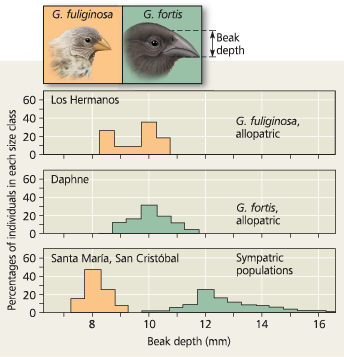
[[Exploitation:[[
A +/‒ ecological interaction in which one species benefits by feeding on the other species, which is harmed. Exploitative interactions include predation, herbivory, and parasitism
[[Predation:[[
An interaction between species in which one species, the predator, eats the other, the prey
[[Aposematic Coloration:[[
The bright warning coloration of many animals with effective physical or chemical defenses
Examples of defensive adaptations in animals

Explain how natural selection could increase the resemblance of a harmless species to a distantly related harmful species. Along with selection, what else could account for a harmless species resembling a closely related harmful species?
Individuals of a harmless species that resembled a distantly related harmful species might be attacked by predators less often than other individuals of the harmless species that did not resemble the harmful species. As a result, individuals of the harmless species that resembled a harmful species would tend to contribute more offspring to the next generation than would other individuals of the harmless species. Over time, as natural selection by predators continued to favor those individuals of the harmless species that most closely resembled the harmful species, the resemblance of the harmless species to the harmful species would increase. Selection is not the only process that could cause a harmless species to resemble a closely related harmful species. In this case, the two species also could resemble each other because they descended from a recent common ancestor and hence share many traits (including a resemblance to one another)
[[Batesian Mimicry:[[
A type of mimicry in which a harmless species resembles an unpalatable or harmful species to which it is not closely related
[[Herbivory:[[
A +/‒ interaction in which an organism eats parts of a plant or alga
[[Parasitism:[[
A +/‒ ecological interaction in which one organism, the parasite, benefits by feeding upon another organism, the host, which is harmed; some parasites live within the host (feeding on its tissues), while others feed on the host’s external surface
[[Parasite:[[
An organism that feeds on the cell contents, tissues, or body fluids of another species (the host) while in or on the host organism. Parasites harm but usually do not kill their host
[[Host:[[
The larger participant in a symbiotic relationship, often providing a home and food source for the smaller symbiont
[[Endoparasites:[[
A parasite that lives within a host
[[Ectoparasites:[[
A parasite that feeds on the external surface of a host
[[Positive Interactions:[[
A +/+ or +/0 ecological interaction in which at least one of the interacting species benefits and neither is harmed; positive interactions include mutualism and commensalism
[[Mutualism:[[
A +/+ ecological interaction that benefits each of the interacting species
Acacia Trees and Ants
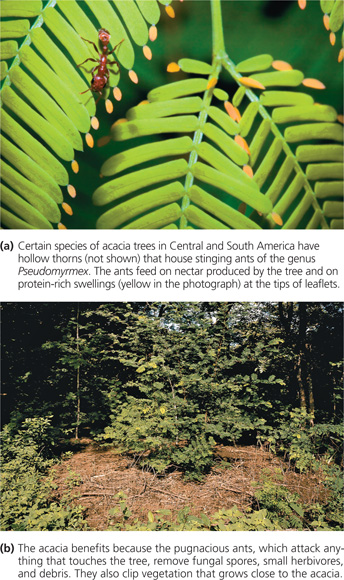
[[Commensalism:[[
A +/0 ecological interaction in which one organism benefits but the other is neither helped nor harmed
Cattle egrets and an African buffalo
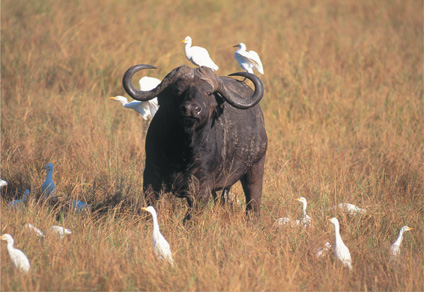
Facilitation by black rush (Juncus gerardii) in New England salt marshes - Black rush increases the number of plant species that can live in the upper middle zone of the marsh
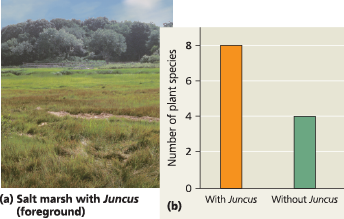
Explain how interspecific competition, predation, and mutualism differ in their effects on the interacting populations of two species
Interspecific competition has negative effects on both species (−/−). In predation, the predator population benefits at the expense of the prey population; this is an example of exploitative interaction (+/−). Mutualism is an interaction in which both species benefit (+/+)
According to the principle of competitive exclusion, what outcome is expected when two species with identical niches compete for a resource? Why?
One of the competing species will become locally extinct because of the greater reproductive success of the more efficient competitor
Figure 22.13 illustrates how a hybrid zone can change over time. Imagine that two finch species colonize a new island and are capable of hybridizing (mating and producing viable offspring). The island contains two plant species, one with large seeds and one with small seeds, growing in isolated habitats. If the two finch species specialize in eating different plant species, would reproductive barriers be reinforced, weakened, or unchanged in this hybrid zone?
By specializing in eating seeds of different plant species, individuals of the two finch species may be less likely to come into contact in the separate habitats, reinforcing a reproductive barrier to hybridization
For each interaction listed in the table, give an example of a pair of species that exhibit the interaction 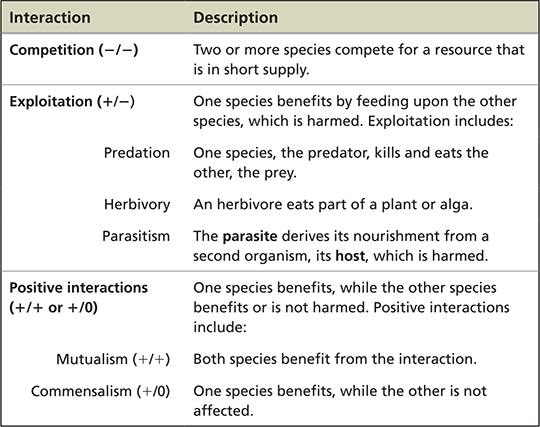
Competition: a fox and a bobcat competing for prey. Predation: an orca eating a sea otter. Herbivory: a bison grazing in a prairie. Parasitism: a parasitoid wasp that lays its eggs on a caterpillar. Mutualism: a fungus and an alga that make up a lichen. Commensalism: a beetle (that feeds upon wildflowers growing in a maple forest) and a maple tree
41.2 - Diversity and trophic structure characterize biological communities
Species diversity is affected by both the number of species in a community—its species richness—and their relative abundance. A community with similar abundances of species is more diverse than one in which one or two species are abundant and the remainder are rare
Trophic structure is a key factor in community dynamics. Food chains link the trophic levels from producers to top carnivores. Branching food chains and complex trophic interactions form food webs
Dominant species are the most abundant species in a community. Keystone species are usually less abundant species that exert a disproportionate influence on community structure. Ecosystem engineers influence community structure through their effects on the physical environment
The bottom-up model proposes a unidirectional influence from lower to higher trophic levels, in which nutrients and other abiotic factors primarily determine community structure. The top-down model proposes that control of each trophic level comes from the trophic level above, with the result that predators control herbivores, which in turn control primary producers
[[Species Diversity:[[
The number and relative abundance of species in a biological community
[[Species Richness:[[
The number of species in a biological community
[[Relative Abundance:[[
The proportional abundance of different species in a community
Compare communities 1 and 2 
The species richness is the same for both communities because they both contain four species of trees, but the relative abundance is very different. Community 1 is more diverse which makes it more stable
Which forest is more diverse? - Ecologists would say that community 1 has greater species diversity, a measure that includes both species richness and relative abundance
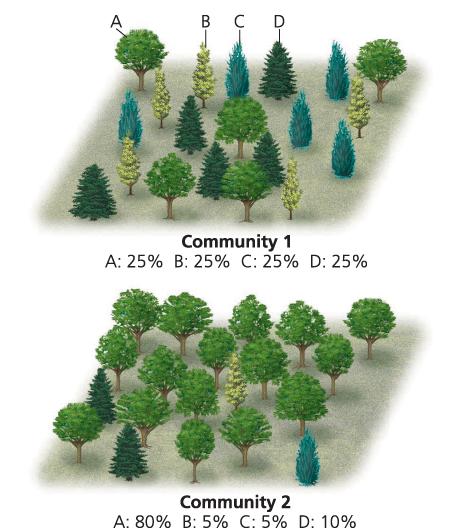
Shannon Diversity Index:
x x ![]()
[[Biomass:[[
The total mass of organic matter comprising a group of organisms in a particular habitat
[[Invasive Species:[[
A species, often introduced by humans, that takes hold outside its native range
Describe the characteristics of a community that is more resistant to invasive species than others
Higher diversity communities are more resistant. They capture more of the resources available in the system, leaving fewer resources for the invader and decreasing its survival
[[Trophic Structure:[[
The different feeding relationships in an ecosystem, which determine the route of energy flow and the pattern of chemical cycling
[[Food Chain:[[
The pathway along which food energy is transferred from trophic level to trophic level, beginning with producers
Examples of food chains - The arrows trace energy and nutrients that pass through the trophic levels of a community when organisms feed on one another. Decomposers, which feed on the remains of organisms from all trophic levels, are not shown here
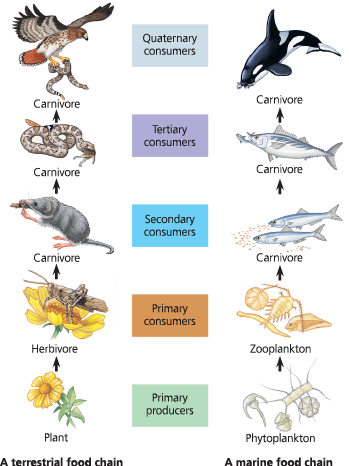
Suppose the abundance of carnivores that eat zooplankton increased greatly. How might that affect phytoplankton abundance?
An increase in the abundance of carnivores that ate zooplankton might cause zooplankton abundance to drop, thereby causing phytoplankton abundance to increase
[[Food Webs:[[
The interconnected feeding relationships in an ecosystem
An Antarctic marine food web - Arrows follow the transfer of food from the producers (phytoplankton) up through the trophic levels. For simplicity, this diagram omits decomposers

In the food web shown here, indicate the number of organism types that each group eats. Which two groups are both predator and prey for each other?
The number of other organism types eaten is zero for phytoplankton; one for copepods, crabeater seals, baleen whales, and sperm whales; two for krill, carnivorous plankton, and elephant seals; three for squids, fishes, leopard seals, and humans; and five for birds and smaller toothed whales. The two groups that both consume and are consumed by each other are fishes and squids
Of the food web, which organisms have most likely accumulated the most toxins?
Smaller-toothed whales, baleen whales, sperm whales, and humans most likely. They are at the top of the food chain which means more events have occurred letting more toxins build up before the energy reaches them. Plus, they have a longer lifespan. Both are reasons why they likely have the most toxins.
[[Dominant Species:[[
A species with substantially higher abundance or biomass than other species in a community. Dominant species exert a powerful control over the occurrence and distribution of other species
[[Keystone Species:[[
A species that is not necessarily abundant in a community yet exerts strong control on community structure by the nature of its ecological role or niche
A type of elephant is removed from a stable and diverse community. This results in a less structures community which indicates the elephant is a ___
- keystone species
Pisaster Keystone
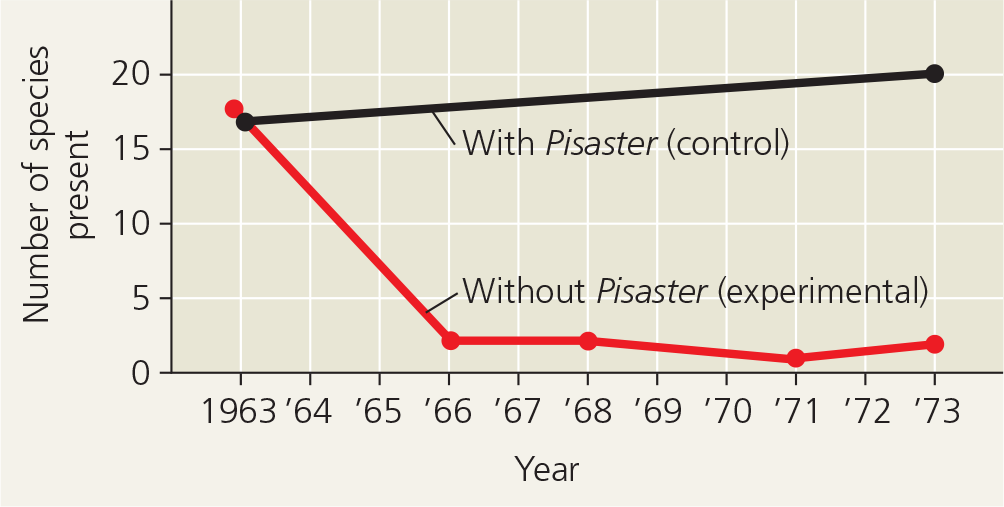
Suppose that an invasive fungus killed most individuals of Mytilus at these sites. Predict how species richness would be affected if Pisaster were then removed
The death of individuals of Mytilus, a dominant species, should open up space for other species and increase species richness even in the absence of Pisaster
[[Ecosystem Engineers:[[
An organism that influences community structure by causing physical changes in the environment
Beavers as ecosystem engineers - By felling trees, building dams, and creating ponds, beavers can transform large areas of forest into flooded wetlands
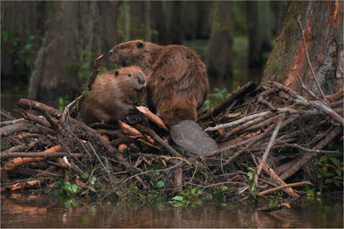
Describe three possible relationships (V→H, V<-H, V↔H)between vegetation and herbivores
The arrows indicate that a change in the biomass of one trophic level causes a change in the other trophic level. V → H means that an increase in vegetation will increase the numbers or biomass of herbivores, but not vice versa. In this situation, herbivores are limited by vegetation, but vegetation is not limited by herbivory. In contrast, V ← H means that an increase in herbivore biomass will decrease the abundance of vegetation, but not vice versa. A double-headed arrow indicates that each trophic level is sensitive to changes in the biomass of the other
[[Bottom-Up Model:[[
A model of community organization in which mineral nutrients influence community organization by controlling plant or phytoplankton numbers, which in turn control herbivore numbers, which in turn control predator numbers
What is the simplified bottom-up model?
Mineral nutrients → vegetation → herbivores → predators
[[Top-Down Model:[[
A model of community organization in which predation influences community organization by controlling herbivore numbers, which in turn control plant or phytoplankton numbers, which in turn control nutrient levels; also called the trophic cascade model
What is the simplified top-down model (tropic cascade model)?
Mineral nutrients <- vegetation <- herbivores <- predators
Why do the effects thus move down the trophic structure as alternating +/– effects?
Removing the top carnivores will increase the abundance of primary carnivores, in turn decreasing the number of herbivores, increasing phytoplankton abundance, and decreasing concentrations of mineral nutrients
[[Biomanipulation:[[
An approach that applies the top-down model of community organization to alter ecosystem characteristics. For example, ecologists can prevent algal blooms and eutrophication by altering the density of higher-level consumers in lakes instead of by using chemical treatments
Results of biomanipulation in a lake with top-down control of community organization - Decreasing the abundance of fish that ate zooplankton results in a decrease in the biomass of algae, improving water quality
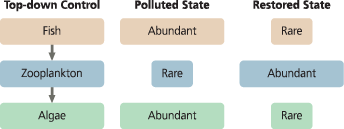
What two components contribute to species diversity? Explain how two communities with the same number of species can differ in species diversity
Species richness (the number of species in the community) and relative abundance (the proportions of the community represented by the various species) both contribute to species diversity. Compared to a community with a very high proportion of one species, one with a more even proportion of species is considered more diverse
How is a food chain different from a food web?
A food chain presents a set of one-way transfers of food energy up to successively higher trophic levels. A food web documents how food chains are linked together, with many species weaving into the web at more than one trophic level
Consider a grassland with five trophic levels: grasses, mice, snakes, raccoons, and bobcats. If you released additional bobcats into the grassland, how would grass biomass change if the bottom-up model applied? If the top-down model applied?
According to the bottom-up model, adding extra predators would have little effect on lower trophic levels, particularly vegetation. If the top-down model applied, increased bobcat numbers would decrease raccoon numbers, increase snake numbers, decrease mouse numbers, and increase grass biomass
Rising atmospheric CO2 levels lead to ocean acidification (see Figure 2.24) and global warming, both of which can reduce krill abundance. Predict how a drop in krill abundance might affect other organisms in the food web shown in Figure 41.14. Which organisms are particularly at risk?
A decrease in krill abundance might increase the abundance of organisms that krill eat (phytoplankton and copepods), while decreasing the abundance of organisms that eat krill (baleen whales, crabeater seals, birds, fishes, and carnivorous plankton); baleen whales and crabeater seals might be particularly at risk because they only eat krill. However, many of these possible changes could lead to other changes as well, making the overall outcome hard to predict. For example, a decrease in krill abundance could cause an increase in copepod abundance—but an increase in copepod abundance could counteract some of the other effects of decreased krill abundance (since like krill, copepods eat phytoplankton and are eaten by carnivorous plankton and fishes)
Based on indexes such as Shannon diversity, is a community of higher species richness always more diverse than a community of lower species richness?
Not necessarily if the more species-rich community is dominated by only one or a few species
41.3 - Disturbance influences species diversity and composition
Increasing evidence suggests that disturbance and lack of equilibrium, rather than stability and equilibrium, are the norm for most communities. According to the intermediate disturbance hypothesis, moderate levels of disturbance can foster higher species diversity than can low or high levels of disturbance
Ecological succession is the sequence of community and ecosystem changes after a disturbance. Primary succession occurs where no soil exists when succession begins; secondary succession begins in an area where soil remains after a disturbance
Humans are the most widespread agents of disturbance, and their effects on communities often reduce species diversity
[[Stability:[[
A community’s tendency to reach and maintain a relatively constant composition of species
[[Climax Community:[[
An ecological community in which populations of plants or animals remain stable and exist in balance with each other and their environment
[[Disturbance:[[
A natural or human-caused event that changes a biological community and usually removes organisms from it. Disturbances, such as fires and storms, play a pivotal role in structuring many communities
[[Nonequilibrium Model:[[
A model that maintains that communities change constantly after being buffeted by disturbances
[[Intermediate Disturbance Hypothesis:[[
The concept that moderate levels of disturbance can foster greater species diversity than low or high levels of disturbance
Testing the intermediate disturbance hypothesis - Researchers identified the taxa (species or genera) of invertebrates at two locations in each of 27 New Zealand streams. They assessed the intensity of flooding at each location using an index of streambed disturbance. The number of invertebrate taxa peaked where the intensity of flooding was at intermediate levels
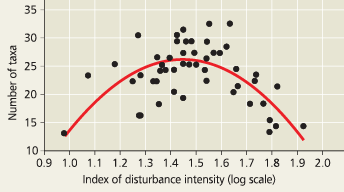
Small-scale disturbances can create patches of ___ across a landscape, which help maintain _ in a community
- different habitats; diversity
Recovery following a large-scale disturbance - The 1988 Yellowstone National Park fires burned large areas of forests dominated by lodgepole pines
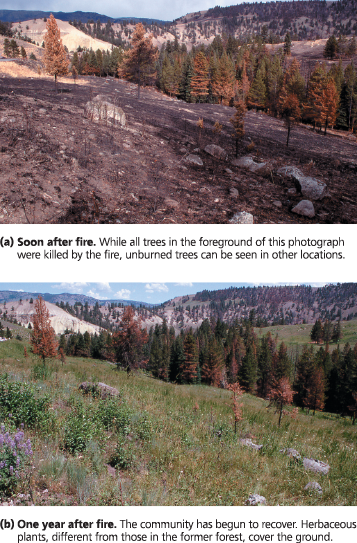
[[Ecological Succession:[[
Transition in the species composition of a community following a disturbance; establishment of a community in an area virtually barren of life
Succession
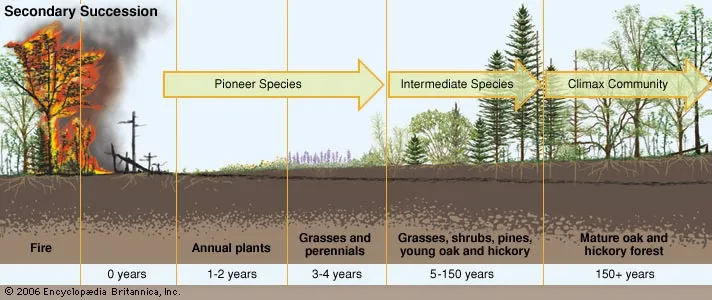
[[Primary Succession:[[
A type of ecological succession that occurs in an area where there were originally no organisms present and where soil has not yet formed
Primary succession - It starts before soil but in the presence of rocks. Organisms die which adds nutrients tot he soil allowing for even more and larger organisms to survive
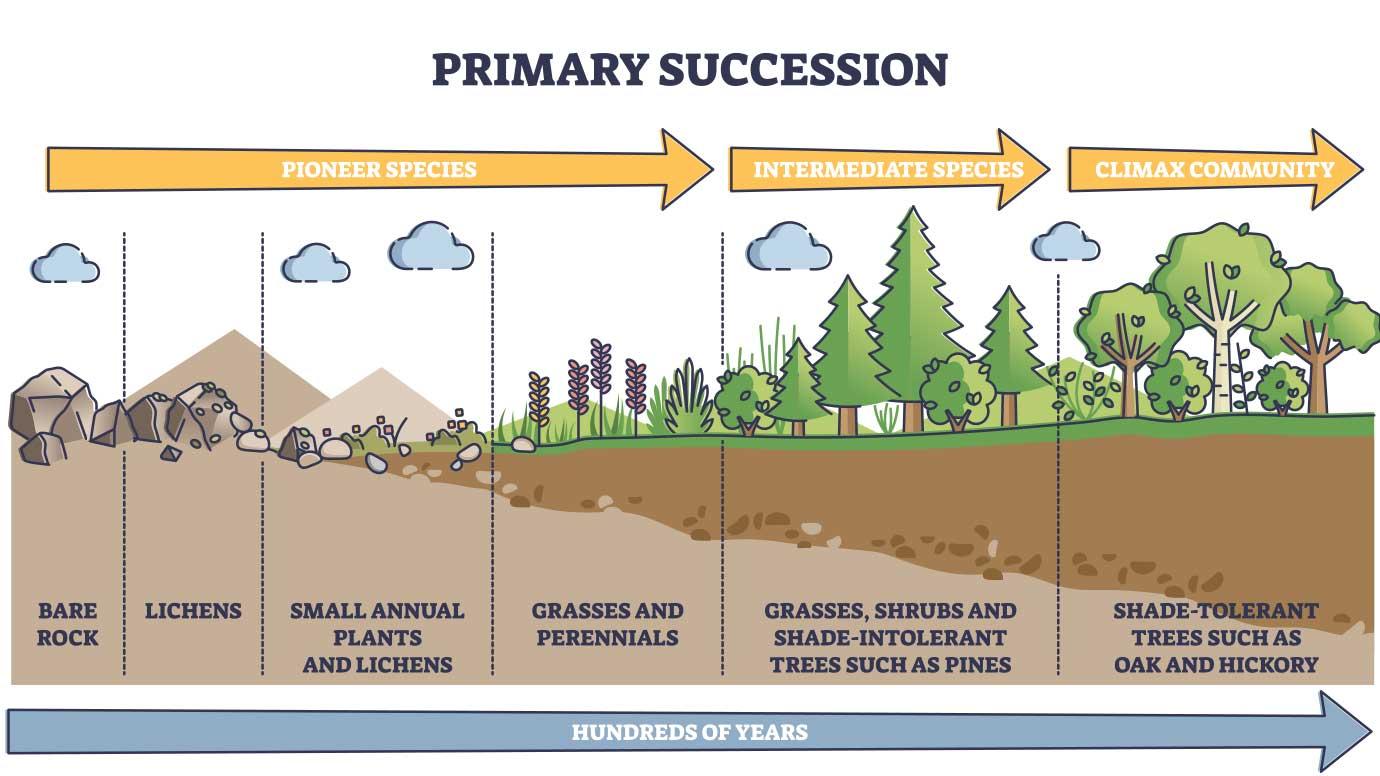
[[Secondary Succession:[[
A type of succession that occurs where an existing community has been cleared by some disturbance that leaves the soil or substrate intact
Secondary succession - While a disturbance has killed the organisms, there is still soil so it is not completely starting over
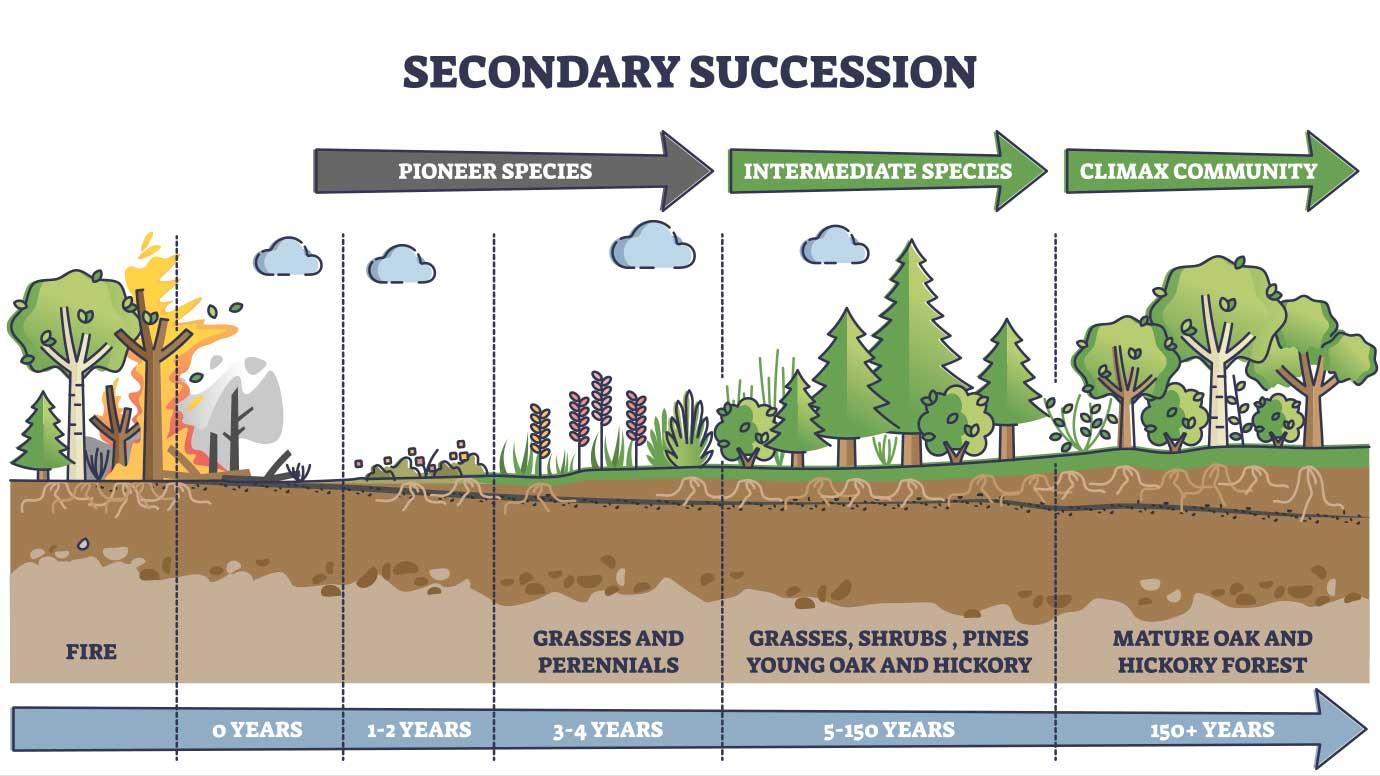
During primary succession, the only life-forms initially present are often ___
- prokaryotes and protists
How can new species facilitate the appearance of the later species?
They make the environment more favorable (adding nutrients or increasing the fertility of soil)
How can new species inhibit the appearance of the later species?
They can decrease the probability that a second species will be present (competition, predation, parasitism)
How can new species tolerate the appearance of the later species?
They are independent of other species and are neither helped nor hindered by early species
Glacial retreat and primary succession at Glacier Bay, Alaska
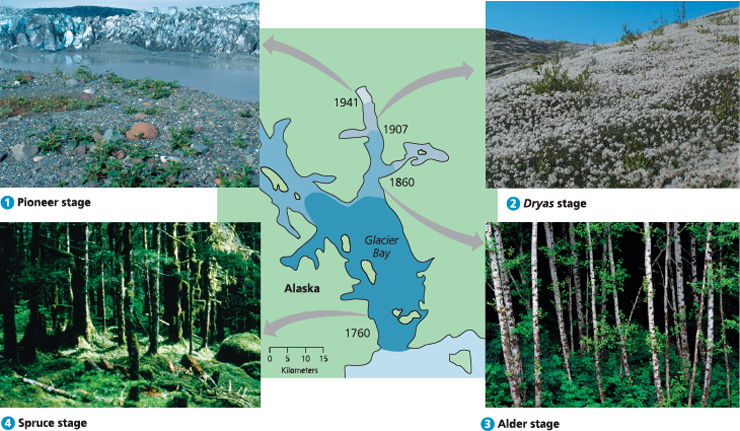
Ecological succession is a response to disturbance of the environment, and the strongest disturbances are ___
- human activities
Disturbance of the ocean floor by trawling
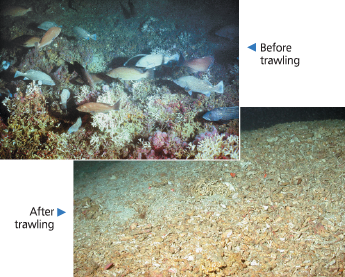
Why do high and low levels of disturbance usually reduce species diversity? Why does an intermediate level of disturbance promote species diversity?
High levels of disturbance are generally so disruptive that they eliminate many species from communities, leaving the community dominated by a few tolerant species. Low levels of disturbance permit competitively dominant species to exclude other species from the community. On the other hand, moderate levels of disturbance can facilitate coexistence of a greater number of species in a community by preventing competitively dominant species from becoming abundant enough to eliminate other species from the community
During succession, how might the early species facilitate the arrival of other species?
Early successional species can facilitate the arrival of other species in many ways, including increasing the fertility or water-holding capacity of soils or providing shelter to seedlings from wind and intense sunlight
Most prairies experience regular fires, typically every few years. If these disturbances were relatively modest, how would the species diversity of a prairie likely be affected if no burning occurred for 100 years?
The absence of fire for 100 years would represent a change to a low level of disturbance. According to the intermediate disturbance hypothesis, this change should cause diversity to decline as competitively dominant species gain sufficient time to exclude less competitive species
Is the disturbance pictured in Figure 41.21 more likely to initiate primary or secondary succession?
Similar to clear-cutting a forest or plowing a field, some species would be present initially. As a result, the disturbance would initiate secondary succession in spite of its severe appearance
41.4 - Biogeographic factors affect community diversity
Species richness generally declines along a latitudinal gradient from the tropics to the poles. Climate influences the diversity gradient through energy (heat and light) and water. The greater age of tropical environments also may contribute to their greater species richness
Species richness is directly related to a community’s geographic size, a principle formalized in the species-area curve. The island equilibrium model maintains that species richness on an ecological island reaches an equilibrium where new immigrations are balanced by extinctions
Two key factors that can affect latitudinal gradients of species richness are ___
- evolutionary history and climate
Tropical communities are generally older than others. ___ may be highest here because there has been more time for _ to occur
- Species diversity; speciation
[[Evapotranspiration:[[
The total evaporation of water from an ecosystem, including water transpired by plants and evaporated from a landscape, usually measured in millimeters and estimated for a year
[[Potential Evapotranspiration:[[
The measure of potential water loss that assumes that water is readily available
Energy, water, and species richness - Vertebrate species richness in North America increases predictably with potential evapotranspiration, expressed as rainfall equivalents (mm/yr)
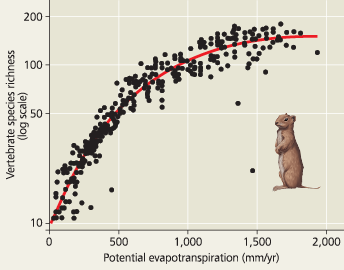
[[Species-Area Curve:[[
The biodiversity pattern that shows that the larger the geographic area of a community, the more species it has
Describe two hypotheses that explain why species diversity is greater in tropical regions than in temperate and polar regions
Ecologists propose that the greater species richness of tropical regions is the result of their longer evolutionary history and the greater solar energy input and water availability in tropical regions
Describe how an island’s size and distance from the mainland affect the island’s species richness
Immigration of species to islands declines with distance from the mainland and increases with island area. Extinction of species is lower on larger islands and on less isolated islands. Since the number of species on islands is largely determined by the difference between rates of immigration and extinction, the number of species will be highest on large islands near the mainland and lowest on small islands far from the mainland
Based on MacArthur and Wilson’s island equilibrium model, how would you expect the richness of birds on islands to compare with the richness of snakes and lizards?
Because of their greater mobility, birds disperse to islands more often than snakes and lizards, so birds should have greater richness
How have periods of glaciation influenced latitudinal patterns of diversity?
Glaciations are major disturbances that can completely destroy communities found in temperate and polar regions. As a result, tropical communities are older than temperate or polar communities. This can cause species diversity to be high in the tropics simply because there has been more time for speciation to occur
41.5 - Pathogens alter community structure locally and globally
Recent work has highlighted the role that pathogens play in structuring terrestrial and marine communities
Zoonotic pathogens are transferred from other animals to humans. Community ecology provides the framework for identifying key species interactions associated with such pathogens and for helping us track and control their spread
[[Pathogens:[[
An organism or virus that causes disease
[[Zoonotic Pathogens:[[
A disease-causing agent that is transmitted to humans from other animals
[[Vector:[[
An organism that transmits pathogens from one host to another
Unexpected hosts of the Lyme disease pathogen - A combination of ecological data and genetic analyses enabled scientists to show that more than half of ticks carrying the Lyme pathogen became infected by feeding on the short-tailed shrew (Blarina brevicauda) or the masked shrew (Sorex cinereus)
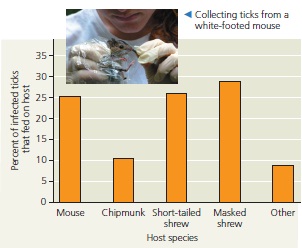
Concept 21.1 describes genetic variation between populations. How might genetic variation between shrew populations in different locations affect the number of infected ticks?
Shrew populations in different locations and habitats might show substantial genetic variation in their susceptibility to the Lyme pathogen. As a result, there might be fewer infected ticks where shrew populations were less susceptible to the Lyme pathogen and more infected ticks where shrews were more susceptible
How do human activities impact the spread of disease?
It allows diseases to be spread rapidly as they are carried by people
What are pathogens?
Pathogens are microorganisms or viruses that cause disease
Rabies, a viral disease in mammals, is not currently found in the British Isles. If you were in charge of disease control there, what practical approaches might you employ to keep the rabies virus from reaching these islands?
To keep the rabies virus out, you could ban imports of all mammals, including pets. Potentially, you could also attempt to vaccinate all dogs in the British Isles against the virus. A more practical approach might be to quarantine all pets brought into the country that are potential carriers of the disease, the approach the British government actually takes
Suppose a pathogen attacks a keystone species. Explain how this could alter the structure of the community
A keystone species is one with a pivotal ecological role. Hence, a pathogen that reduces the abundance or otherwise harms a keystone species could greatly alter the structure of the community. For example, if a novel pathogen drove a keystone species to local extinction, drastic changes in species diversity could occur